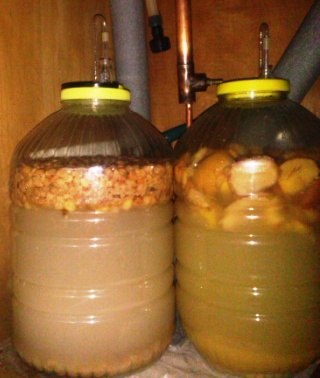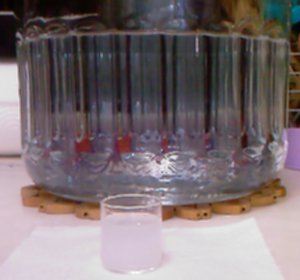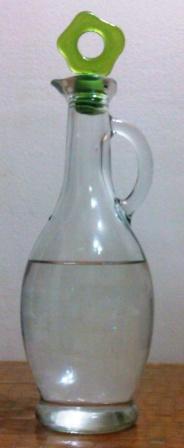
Welcome!
Be part of our community & join our international next generation forum now!
Categories
In this Discussion
Raki
Anise flavored distilled drinks like Raki/Ouzo is the main thing around aegean/east mediterranean sea and has years of tradition behind them. Anise is good for the stomach, maybe it is why raki is usually enjoyed with food, mostly at dinner which I think fills a gap there.
As stated in a study, commercial brands do it as follows:
- Ferment raisins to 8% abv and strip.
- Dilute low wines and feints down to 45% abv and mix with anise seeds at a ratio of 6-10% of total volume and do a sprit run.
- Collect hearts at around 80% abv.
- Dilute and add sugar. The ratio of sugar being 6 g/L for 50% abv or 4 g/L for 40% abv.
- No need for aging but rest and air occasionaly for 20-120 days, and bottle.
I ended up doing it differently, but let me make some comments first:
- Ferment raisins to 8% abv and strip.
Commercial brands only use raisins or fresh white grapes but it is not the only way to go. Other dried/fresh fruits will do and the flavours carries over nicely. My first wash ever was a melons/sugar wash. Dried Figs are exceptional, Melons are very good. My raisins/sugar wash is very nice, much like the commercial brands, may be a little bit better. Red grapes produced something too strong tastewise but ended up great after oaking. Although I have not tried any grains, I think they would be too strong as well. Maybe a grain and fruit blend may work and can be good after oaking. Ofcourse you can always use neutral.
I am now doing the dried/fresh fruit washes UJ style.
@Punkin said: Also interested in how the fruit works in a ujsm style, can you desribe the process? do you mince the fruit or slice the apples etc?
I simply use my dried/fresh fruits instead of Corn in the UJSSM recipe and do multiple generations without using backset with good results always.
These fermentations tend to become acidic rapidly which supposedly brings out more flavours. Thus no need for using backset for souring and to my taste I think backset affects flavours negatively with fruits, at least with the ones that I tried so far.

I remove the seeds and possible rots (in case of apples) and cut to four as seen in the picture. In case of grapes I simply put them as they are. At the bottom of the fermentors, some pulp develops on its own which I think brings out more flavour.
I aim for a SG 1060-1065 which diminishes the possible negative effects of using sugar on the flavour. Also, I don't invert or melt sugars anymore. I simply put sugar as the last thing to my fermentor and stir a bit till everything mixes. When settled, there is a layer of sugar at the bottom and melts away in a couple of days. This way my starting SG is lower which is around 1025-1030 and continues to be there till all the sugars melt. I think this also helps with flavour and yeasts seem to be happy.
The beauty of UJSSM style is it is continuous and very simple to prepare every generation once it is going on. Also the yeast always works in an environment that it is familiar with.
- Dilute low wines and feints down to 45% abv and mix with anise seeds at a ratio of 6-10% of total volume and do a sprit run.
I am not sure that the 6-10% ratio for the anise amount gets enough anethole (the essential oil of anise) in the product for us. Maybe because of their scale or maybe being able to get better/fresh anise works for the commercials. I had better results with 15-20% ratio. However, with my current method I am relieved from the task of finding a good ratio as I will explain later, which also allows me to use much less anise.
The sprit becomes milky white when you dilute below 38% ABV which is called a louche. A word I think comes from absinthe culture. Having enough anethole simply means that you should be able to get a louche.

Putting 45% abv in the boiler seems to be high. I am sure factories know what they are doing. When using this method I did not exceed 40%. However, they may have a good reason to go that high.
- Collect hearts at around 80% abv.
As commercials aim for 80% using an alembic, it must be helping them to have the low wines in the boiler at 45%. But for us, we know, by simply adding a thumper or some buble caps we can easily get there and don't have to charge our boiler that high.
80% abv is spot on and it smells delicious. Below that you don't get enough anethole infusion thus no louche.
Checking for louche after watering when making cuts, is a good way to be sure about having enough anethole in the product.
During my first trials overcooked smell was all over. I think mainly because I was using direct heat (gas) and as the amount of alcohol diminishes in the boiler I was cooking a soup of anise . May be that is why the commercials are using steam to heat their alembics.
To solve that problem, I tried diluting my hearts to 40% and redistilling. It was exceptional. So, if you are to follow the method that the commercials use, you can take one more step and try redistilling your hearts. You might like it.
- Dilute and add sugar. The ratio of sugar being 6 g/L for 50% abv or 4 g/L for 40% abv.
Adding a bit of sugar is good. It helps in blending water, alcohol and flavours better.
- No need for aging but rest and air occasionaly for 20-120 days, and bottle.
It is good to be able to drink what you produce right away. Resting for a while helps sugar to do its job better. I can't say for how long though. However it seems my stock seems to taste better and better as it waits to be enjoyed.
I dilute down to 47-48% when bottling. I found below that, when I put my bottle in the refrigerator I get a louche. It disappears after warming up a little at room temperature but I like my raki chilled. I think this happens because I have more anethole in my raki than the commercial ones. To be safe, one can dilute down to 50% for bottling and never have such a problem.

This is the basic idea of doing raki/ouzo with a pot.
I followed this procedure when I first started but the product was not good enough. The main problem was coming from overcooking the anise. Sometimes the amount of anise was not enough, and sometimes it was too much. The overcooked smell was always there. Redistilling the hearts solved all the problems. But as I was diluting for each sprit run I was loosing some flavours.
I also tried using a thumper and put anise in it instead of the boiler, which was an improvement. The taste was better and used less anise.
After that I tried doing it like gin and things improved some more.
Next I will write how I do it now.
Cheers,
Sadi







Comments
Amazing writeup @Sadi and looking forward to more.
Fantastic post mate. Looking forward to the next one. Are you producing commercially over there? i seem to recall you were aiming to?
StillDragon Australia & New Zealand - Your StillDragon® Distributor for Australia & New Zealand
I admit @Sadi gave me more of a handle on the louching thing. I often mistook it as a defect instead of an indicator.
Thank you for the kind words mates.
Oh no mate, I am retired.
My interest in Water of Life is purely Spritual. :)
Here is what I do now:
As my experience in fermenting and distilling improved, I now focus more on quality of the end product which I believe starts with the quality of the materials that are used.
Using the method described above, I try to make a good wine/wash. After ferment gets dry I rack and let it rest for a couple of days till most of the things like yeast and pulp that I don't want to cook settle down. I rack again and wait some more.
I charge my boiler with wine/wash and add feints to it. I tried many configs for the column and settled with four plates. The middle two is filled with anise. More in the second and less in the third. First and fourth is filled with some glass packing.
During the run, I try to keep abv near 80% as long as possible. Below that there is not enough anethole infusion and above that perhaps some flavours may be lost.
I don't have pics of the above mentioned setup, but this one may give you the idea.
The parrot is not that clear but you can see the alcometer in it.
Although this is a strip run, I make cuts.
After a bit of foreshots, I get some heads in the feints container. Using smell and taste on my finger, when headsy smells are about to end I change containers and start collecting hearts.
At this stage I keep a close watch on the run. Occaisonally, I put a few ml of water in a small glass and take the alcometer from the parrot and let a few drops from it in the glass and check if it becomes white. I smell the alcometer and taste and smell what is in the glass just for the fun of it mostly. :)
I put the alcometer back in the parrot and watch the abv and check the louche from time to time. When the louche starts to be less or none I change the containers and start collecting in feints container. I increase the heat and collect down to 15-20%.
This way I don't get the overcooked smell of anise and I make sure that there is enough anethole in the middle cut. I don't have to worry about any anise ratios as mentioned in the first part when describing doing it with a pot still. I use a lot less anise also.
I rest the "hearts cut" for a couple of days and then do a sprit run with two plates charging the boiler at around 27-30% abv. I collect a bit of heads and then hearts in 250ml behers and check for louche towards the end to decide when tails start. Heads and tails go to the feints container and I let the hearts air, usually at least a day and then make cuts.
As you said @Lloyd, I use louching as an indicator throughout the process.
I mentioned in the first part doing three distillations produced good results but this way I think I am getting more flavours. I like to think of it as two and a half distillations.
When doing cuts, I dip a finger and lick to taste the fruit without watering. I think it is more pronounced this way. I smell the glass/beher when full and then pour it in another one and smell what is left in it. Wait for a while and smell again, and repeat a couple of times. This way I found that I can smell different layers of flavours.
Most of the glass/behers smell good and what was in them goes in the product container. I add a teaspoon of sugar (roughly a teaspoon per 1 Liter), give it a good stir/shake and let it rest.
I only dilute to 47% abv when my bottle in the fridge needs refilling and keep the product at high abv when in stock. Although it is good right away, resting for some time seems to improve things some more.
I think I can setup my Crystal Dragon as described above or can try the alternative gin basket for similar results. I will try using it in different ways for sure.
As you see I ended up doing things a bit differently in this hobby while trying and testing different ideas which would not be possible without you friends sharing in forums. Thank you. :)
I hope you liked it so far.
Next I will write about some flavouring trials that I did.
Cheers,
Sadi
Although no commercial examples exist, I have also tried flavoring.
With a strong brandy base, oaking works well. Tried mastic but that was not exciting for me.
Two or three drops of mint extract per 250ml and resting a week or more turned out to be refreshingly good.
I wanted to write about what kind of food and meze that we usually enjoy with raki but instead I found a few commercial videos from youtube. Watching them you can have an idea.
http://www.youtube.com/watch?v=pFKaVjao6js
http://www.youtube.com/watch?v=4DISqO2ZA64
http://www.youtube.com/watch?v=gpSbhw5mrus
http://www.youtube.com/watch?v=7AxTjb5ryQ4
I think this sums it up.
I will see how I will do it with my new setup when I have it and can post a possible configuration then.
Cheers,
Sadi
your are mean! ;) how can you show this stuff on a simple working day? I want to go on holiday to Turkey!!!!! =P~
StillDragon Europe - Your StillDragon® Distributor for Europe & the surrounding area
You are welcome, @Sunshine :)
@Sadi, makes me want to taste some good Raki right now! Looks like we have to come for a visit next time we are in Turkey. ;)
StillDragon Europe - Your StillDragon® Distributor for Europe & the surrounding area
My door is open @SDeurope <:-P
Here are some links that has some info,
Wikipediea and a specific site Raki.com
I am not sure how accurate the online info is Zuliero and I can't offer anything better. :( However, there is a well established tradition and some take it very seriously, which tells me that it should have many centuries of history.
Cheers
@Sadi, I did see the Wiki that is very vague on the historical facts, but the raki.com page is more interresting, thanks! I can imagine the bourgeoisie from the belle époque travelling in the first line of the orient express, bringing with them bottles of absinthe, and bringing back cases of Raki for their friends at home!
Yes @Zuliero that is how it works. :) When my friends go abroad and ask me if I want anything from there I tell them to bring some local sprits, and when they come back we do tastings and they get some bottles of what I make. <:-P
Cheers